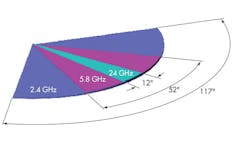Interference-Free Millimeter-Wave Radios Promise Security
No longer relegated to the name “quasi-optics,” millimeter-wave frequencies are now being heavily used and investigated. Such popularity stems from their potential to solve many of the data-rate, spectral congestion, and security issues of lower-frequency technologies. Although millimeter-waves suffer from higher atmospheric and moisture absorption, their narrow beamwidths and high-data-rate capabilities could lead to their prevalence over traditional radio and microwave frequencies. An application note by ShieldTech Systems, titled “Millimeter Radios—Clean Spectrum and Security,” examines the benefits and drawbacks of using unlicensed millimeter-wave radios.
The document points out that free space loss—as well as gaseous losses, rain, and other atmospheric conditions—all play a role in degrading signal strength for millimeter-wave signals. Generally, microwave radios only suffer significant signal degradation as a product of free space loss. As a result, they have much higher potential for penetration in buildings and other structures. Surprisingly, the degraded signal strength could actually benefit millimeter-wave radios, as the noise floor and interference levels could be lower for their receivers. This is because the stray signals would attenuate more heavily than microwave signals prior to reaching the receivers.
Single-Layer PCB Supports Millimeter-Wave Applications
Millimeter-Wave Technology Prepares For A Wealth Of Applications
Spectrum congestion and the ease of signal interception also are concerns for the microwave, 2.4-GHz, and 5-GHz frequency bands. According to the application note, the technology to intercept standard microwave radio signals can cost anywhere from $29.99 to $3000 on scale with the sophistication of the intercept. In contrast, the narrow-beam behavior of millimeter waves naturally creates a higher directional signal. Combining this factor with the higher absorption characteristics of millimeter waves makes intercepting them much more difficult and costly. In fact, the interceptor would have to physically be within the beam’s transmission path with complex and costly equipment on hand. Such factors could make millimeter-wave radios very attractive for commercial applications like point-to-point radios and wireless backhaul.
ShieldTech Systems, 823 Hollywood Blvd., Crownsville, MD 21032; (919) 647-4949
About the Author
Jean-Jacques DeLisle
Jean-Jacques graduated from the Rochester Institute of Technology, where he completed his Master of Science in Electrical Engineering. In his studies, Jean-Jacques focused on Control Systems Design, Mixed-Signal IC Design, and RF Design. His research focus was in smart-sensor platform design for RF connector applications for the telecommunications industry. During his research, Jean-Jacques developed a passion for the field of RF/microwaves and expanded his knowledge by doing R&D for the telecommunications industry.

